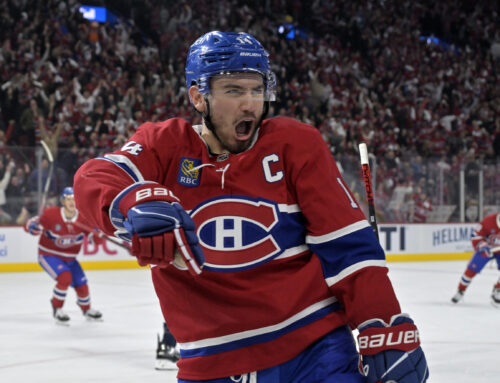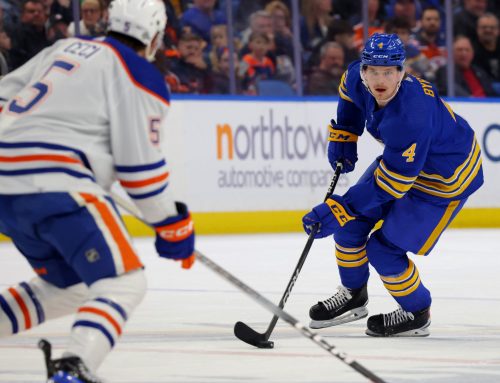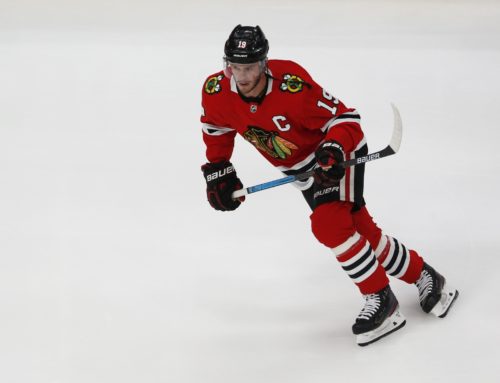
Philadelphia hired Alain Vigneault to be their coach a little while ago and have continued to add to their coaching staff. Monday, it was announced that both Mike Yeo and Michel Therrien will be joining the staff. Therrien was last in the NHL as the head coach for the Habs in the 2016-17 season while Yeo was fired this season by the Blues.
I’m not overly optimistic on this ensemble but I’ve been surprised by coaches before. Let’s see where this goes. It does, however, look more like the Justice League than the Avengers. (Topical!)
*
We got the diagnosis on Cal Clutterbuck’s injuries and the fact he was allowed to play is absurd:
To be clear on Clutterbuck: Stress fracture, two slipped disks and two rotated vertebrae. Could be a major procedure to fix this.
— Arthur Staple (@StapeAthletic) May 6, 2019
This is completely different than playing through a sprained ankle or sore shoulder. This is absolute insanity.
*
Game 6 between Boston and Columbus was a very tight-checking affair. Columbus seemed to hit a post basically every 10 minutes but it was David Krejci who got the scoring going. He hammered home a rebound about halfway through the second period to give Boston a 1-0 lead.
It just wouldn’t be a Stanley Cup playoff elimination game if there wasn’t a penalty controversy.
With under 30 seconds remaining in the second period, Charlie McAvoy did this:
Charlie McAvoy gets two minutes for hitting Josh Anderson up high. Torts isn't happy pic.twitter.com/LsqI28pKZX
— Brady Trettenero (@BradyTrett) May 7, 2019
He was given a 2-minute penalty.
Seems like there's a good case for an ejection. As pointed out by a lot of people on social media, there is no major penalty ruling for a hit to the head. It’s either a 2-minute or a match. Why they wouldn’t just give McAvoy a match, I don’t know. To me, this screams of officials not wanting to hand out a severe penalty because of what happened in the San Jose-Vegas series, and kicking the can to the Department of Player Safety. I can’t imagine we go into the 2019-20 season without some sort of review for major/match penalties.
Marcus Johansson scored the insurance marker on a shot from the slot that leaked through Bobrovsky with 11 minutes left in the third period and David Backes scored a few minutes later. After those goals, it was over for Blue Jackets as the Bruins skated away with a 3-0 win, largely thanks to 39 saves from Rask (and a couple posts). Boston moves on to face Carolina in the Eastern Conference Final.
I’ll have more on Columbus in a Ramblings later this week.
*
We have been promised another Game 7 as Colorado took a thrilling 4-3 overtime win against San Jose to push this series to the limit. It was a highly entertaining game, as the teams traded goals from the second period onward, and Marc-Edouard Vlasic tying things up with about 2:30 left in the game to force overtime in the first place.
Gabriel Landeskog fired home a Cale Makar rebound early in overtime to give the Avalanche at least one more playoff game.
Nathan MacKinnon played 23:22 at even strength in this game, partly because of the desperation to win, partly because the team went with seven defencemen. That mark of 23:22 at even strength was the most in the game of any player outside Brent Burns. A Herculean performance but it’s a wonder how much longer he can keep it up. Not that he was showing any ill effects; he was dominant almost throughout the contest.
Vlasic had a pair of goals in this game and generally has generally had a good postseason. It’s nice to see him bounce back after a rough regular season that feature some injury issues.
Game 7 goes Wednesday night.
*
Looking back on any season, one of the first things I always look to when doing a season review is secondary assists. The reason for that is we know secondary assists at five-on-five are largely random. A player racking up too many or too few secondary assists can lead fantasy owners into a false sense of what that player’s true talent and production levels are. It’s an easy way for fantasy owners to over-draft or under-value someone. One reason (among others) why guys like William Karlsson, Jamie Benn, and Jake DeBrusk were disappointments this season was because they were disappointments was because their secondary assists rate was abnormally high in 2017-18, came down in 2018-19, and fantasy owners were left holding the bag.
Now, it’s not all secondary assists. When discussing fantasy performances for any player, there are several mitigating factors. It’s just that secondary assists are an easy one to pick out. As I’ve stated before in my Ramblings, when participating in fantasy sports, we can’t get the easy ones wrong. Guys we’re almost certain will regress have to be avoided if their price is unjustly inflated. Winning in fantasy sports is hard enough without getting stuffed by the rim when you should just take the easy two and hit the layup.
Now, not everyone with a high secondary assist rate will necessarily crater. Guys like Aleksander Barkov and Nikita Kucherov had high secondary assist rates in 2017-18 but were obviously very good in 2018-19. There are always mitigating factors, like a goal-scoring binge, extra power-play production, or playing on one of the best offensive teams in the last 20 years. Nonetheless, these are forwards with a lot of second assists in 2018-19 that carry concern for one reason or another.
Out of 278 forwards with at least 750 minutes at five-on-five in 2018-19, Tuch led all of them in secondary assists at 1.01 per 60 minutes. He had 44 minutes more ice time in 2018-19 than the year prior and added 12 secondary assists total. Now, it’s fair to say that this was going to go up as he rebounded from a poor on-ice shooting percentage (the rate at which the team scores with him on the ice), as well as an individual points percentage (IPP, or the rate at which he garners a point when a goal is scored with him on the ice). However, rebounding from lows to end up leading the league is obviously a pendulum that has swung too far.
I’ll be very wary of anyone advocating to draft Tuch for the 2019-20 season. Don’t get me wrong, I think he’s a wonderful player. He could be a first liner on some teams, and a sure-fire second liner on almost every team. The problem is that Vegas now has both Mark Stone and Reilly Smith, two right wingers that will play ahead of Tuch on the depth chart. Things can change – we might see Smith moved to the third line sometimes – but I’m not going to bank a breakout season on that happening.
Tuch is a very good player, and could be a very good fantasy asset, but he’s a casualty of a deep forward group that may get deeper with a couple prospects knocking on the door. Combined with a decline in secondary assists next year, I doubt I’ll be drafting Tuch, especially if he gets some Potential Breakouts treatment from the industry in the summer.
A guy with four full NHL seasons under his belt and had never managed to exceed 17 goals or 45 points suddenly broke out for 27 goals and 78 points. Usually not much more needs to be said but it’s worth digging in nonetheless.
Obviously, playing with Sean Monahan and Johnny Gaudreau was a big help. Out of his 1102 minutes at five-on-five, Lindholm skated with those two for 823 of them. In those 823 minutes, the team scored 3.8 goals per 60 minutes. For reference, as a team, the Tampa Bay Lightning scored 3.1 goals per 60 minutes at five-on-five. I don’t think it’s any shock that Gaudreau/Monahan combined for a lot of goals, it’s just a matter of whether they can repeat it.
One thing many people will look to as a reason for Lindholm’s increased production is increased ice time. And it’s true, as Lindholm played over 20 minutes per game this season, over two minutes more per game than in 2017-18. A lot of those minutes came on the power play, as Lindholm’s five-on-five rate only increased by about 30 seconds per game.
We can break down Lindholm’s increased production in three ways:
- Jump in personal shooting percentage at five-on-five from a three-year average of 6.1 percent to 12 percent.
- Increased PP usage on a productive PP unit, pushing him to 26 PPPs from just nine the prior season.
- Secondary assist rate nearly doubling, adding seven assists at five-on-five.
Add the 31 points resulting from those three areas to his 44 points in 2017-18, and you have nearly his entire production jump.
Here’s the thing: I don’t really expect Lindholm’s production to crater in 2019-20. Bill Peters clearly trusts him with heavy minutes and with this level of production, he won’t move to the third line. I do think there are enough indicators of regression, however, that perhaps expecting another production jump may be a bridge too far. I won’t know until I run my projections (that won’t be until July), but my guess is I’ll have him closer to 70 points than improving on 78 points. We’ll have to see where his ADP falls.
Tyler Bertuzzi
Every year, there are a few players upon whom I change my mind greatly for one reason or another. Years ago, it was Johnny Gaudreau. More recently, guys like Kyle Connor and Josh Anderson fit this bill. One player who really grew on me over the course of the 2018-19 season is Tyler Bertuzzi.
I don’t think I’m alone in thinking Bertuzzi would not be a great fantasy asset. He didn’t do much production-wise in junior until his D+2 year, didn’t have a great pedigree, and had just 55 NHL games by the age of 23. Now, he didn’t have a superlative season, but he was serviceable as depth, valuable in cap leagues, and 12 points in 15 March games brought a lot to head-to-head playoffs.
The big warning flag is his five-on-five shooting percentage, which was 13.5 percent. The next warning flag is that he finished sixth among all forwards in secondary assists per 60 minutes. Even just an average secondary assist rate knocks 7-8 points off his total and all of a sudden, a 47-point breakout season becomes a normal 40-or-less point season from a guy who was never thought of as a top offensive prospect.
They key here for Bertuzzi is his role. There is a new general manager in town, and there are good young players coming, but it’ll be at least another year before Detroit can really turn this thing around, I think. That leaves the Red Wings effectively being a one-line team, and if Bertuzzi isn’t on Dylan Larkin’s line, there could be a big decline coming.
On the flipside, if he spends 75 percent of next season alongside Larkin, including the power play, any regression in secondary assists could be made up through more ice time and PP production alone. That’s the double-edged sword here: if he maintains roughly the same TOI but isn’t with Larkin, we could see his production decline, but if he gets more TOI and spends it often with Larkin, we could see improvement production-wise despite that secondary assist regression. To me, Bertuzzi feels like the kind of player who can earn Jeff Blashill’s trust, but there is a very wide range of outcomes here for 2019-20.





 PHI
PHI ANA
ANA VAN
VAN DET
DET BUF
BUF NYR
NYR MIN
MIN
